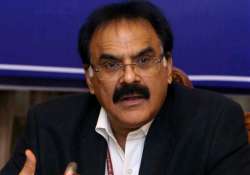Government prefers FDI to boost growth rate to 8 per cent: Finance Secretary
New Delhi: With two successive years of sub-5 per cent growth, Finance Secretary Arvind Mayaram on Tuesday said India would prefer foreign direct investment (FDI) over foreign institutional investor inflows if overseas resources need to

New Delhi: With two successive years of sub-5 per cent growth, Finance Secretary Arvind Mayaram on Tuesday said India would prefer foreign direct investment (FDI) over foreign institutional investor inflows if overseas resources need to be generated to spur economic expansion to its potential level.
"I believe our potential growth rate is 8 per cent. And to get there, we need to develop resources. And that which we cannot generate domestically must come from outside and if it comes from outside then we prefer it in the form of foreign direct investment (FDI) rather than foreign institutional investment (FII)," Mr Mayaram said at an event in Delhi.
India's gross domestic product (GDP) expanded 4.5 per cent in 2012-13 - the slowest pace in the past decade, and at 4.7 per cent in 2013-14. The Reserve Bank of India this month retained its GDP growth estimate of 5-6 per cent in 2014-15.
Foreign investment is considered crucial for India, which needs an estimated $1 trillion, in the five-year period ending March 2017, to overhaul infrastructure such as ports, airports and highways to boost growth. A decline in foreign investment could affect the country's balance of payments and the rupee.
Overall foreign inflows into the country grew 8 per cent to $24.29 billion in the previous financial year from $22.42 billion in 2012-13.
To further attract foreign inflows, the government plans to relax the FDI policy in sectors such as defence, railways and construction activities.
Mr Mayaram emphasised the need to bring India back on the growth path to attract investments.
"You must remember that investments don't come because of agreements like Bilateral Investment Promotion and Protection Agreements. Investments come if there are opportunities to make profits. Opportunity to make profits can only happen when growth is higher and when the economy becomes robust," he said.
On Sunday, Mr Mayaram said at G-20 meeting in Australia that the policies of the new government will deepen the reform process to put the economy on a sustainable and balanced high-growth path.
"I believe our potential growth rate is 8 per cent. And to get there, we need to develop resources. And that which we cannot generate domestically must come from outside and if it comes from outside then we prefer it in the form of foreign direct investment (FDI) rather than foreign institutional investment (FII)," Mr Mayaram said at an event in Delhi.
India's gross domestic product (GDP) expanded 4.5 per cent in 2012-13 - the slowest pace in the past decade, and at 4.7 per cent in 2013-14. The Reserve Bank of India this month retained its GDP growth estimate of 5-6 per cent in 2014-15.
Foreign investment is considered crucial for India, which needs an estimated $1 trillion, in the five-year period ending March 2017, to overhaul infrastructure such as ports, airports and highways to boost growth. A decline in foreign investment could affect the country's balance of payments and the rupee.
Overall foreign inflows into the country grew 8 per cent to $24.29 billion in the previous financial year from $22.42 billion in 2012-13.
To further attract foreign inflows, the government plans to relax the FDI policy in sectors such as defence, railways and construction activities.
Mr Mayaram emphasised the need to bring India back on the growth path to attract investments.
"You must remember that investments don't come because of agreements like Bilateral Investment Promotion and Protection Agreements. Investments come if there are opportunities to make profits. Opportunity to make profits can only happen when growth is higher and when the economy becomes robust," he said.
On Sunday, Mr Mayaram said at G-20 meeting in Australia that the policies of the new government will deepen the reform process to put the economy on a sustainable and balanced high-growth path.